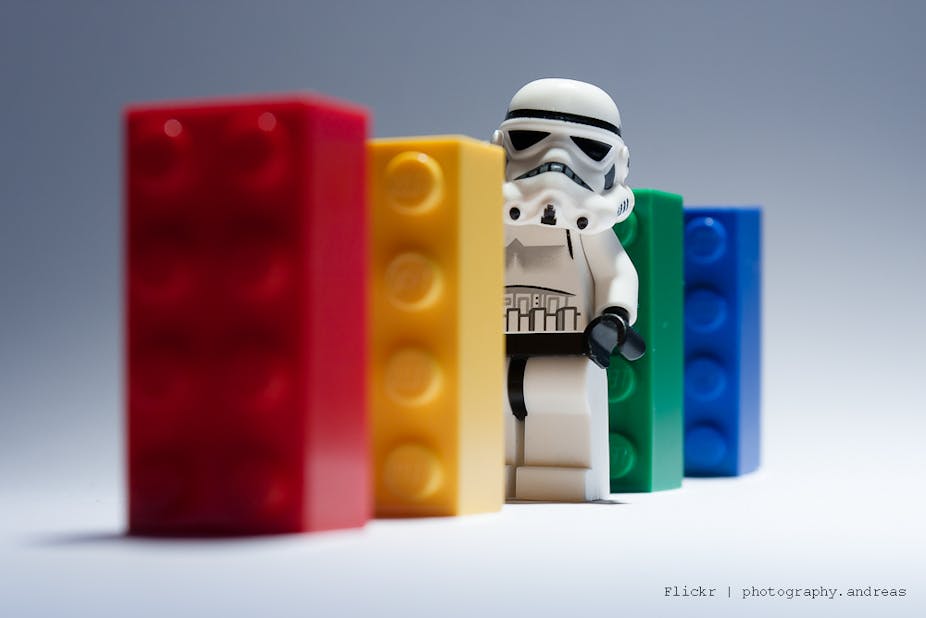“Danish design” usually conjures up images of mid-century modern furniture – functional yet sculptural – but Denmark’s most successful “design icon” is a humble plastic brick: Lego.
In 2013, the Lego Group manufactured more than 55 billion Lego pieces. By the time you have finished reading this article, another half a million plastic bricks will leave Lego factories in Denmark, Hungary, the Czech Republic and Mexico for export to more than 130 countries.
But the plastic bricks now comprise only part of the story, and Lego’s recent success in licensing, video games and films means the physical bricks are now inseparable from their (and our) interactions with virtual media.
Once a basic module of a construction system for children’s play, the Lego brick has now become a basic module of virtual “brickworlds”.

Play well
Lego’s story begins in 1932 in Billund, Denmark, when carpenter Ole Kirk Kristiansen founded a wooden toy business. Still based in Billund and still owned by the Kristiansen family, the Lego Group is currently the world’s largest toy manufacturer, with profits measured in the hundreds of millions of dollars.
The name Lego is a conjunction of the Danish words “leg godt”, meaning “play well”. The initial focus was wooden toys but, following the second world war, Ole’s son Godtfred took over the business and bought their first plastic moulding machine. By 1949, Lego was designing and manufacturing around 200 different toys, including a forerunner of the plastic brick.

A major turning point came in 1958, with the patent of Lego’s “stud-and-tube” coupling system. The simple construction system comprised interchangeable plastic bricks designed to interlock in various combinations. A play system that was non-violent, non-gender specific and stimulated children’s creativity and imagination proved so successful that by the late 1960s, Lego’s expanding range of plastic brick sets was a rapidly growing global export.
Mediatisation
The intersection of advertising, children’s television and toy manufacturers in the 1960s and 1970s meant children were increasingly associating toys with characters and narratives derived from television.
For Lego, the launch of minifigures (minifigs) in 1975 was a significant turning point in the progression towards more narrative play sets, with Space and Town and Castle sets creating a new dimension for the bricks. No longer limited to building anonymous structures, children could now construct homes for knights and spaceships for astronauts.

In 1998, a Star Wars licensing agreement meant that children were playing with not simply generic astronauts or cowboys but specific characters from popular films. Described by film and media studies professor Stig Hjarvard as mediatisation, this process began Lego’s shift in emphasis from designing physical toys to designing media entertainment.
The plastic bricks remained, but became inseparable from their virtual “brickworlds” – from Harry Potter to Lego’s own fantasy world of Bionicles.
While the shift from a simple construction system to integrated cross marketing with popular films, videogames and associated merchandising has caused some concern among parents, it has proven enormously profitable for the Lego Group.
Did the shift from an open construction system of bricks without a script, to a “mediatised” set with instructions and narrative represent a limiting of children’s imaginations and a narrowing of possibilities? Has integration into a wider commercial media culture meant that Lego is now, as one media critic Philip Kennicot recently put it, “commercialised play that encourages a nexus of pre-packaged narrative and consumerist desire in kids”?

Lego mash-ups
As I was unsure of how Lego is perceived by its users, I asked a six-year-old expert (my son) why he liked Lego. “Because you can make anything you want, smash it up, and then make something different,” he replied. After a lengthy conversation about Lego, I realised he didn’t mention Star Wars, Harry Potter or The Lego Movie (even though he has Lego sets from all of these) but kept returning to the process of making and remaking.

Unlikely to keep the original instructions and recreate exact movie scenes, children still create their own structures and stories using Lego bricks.
Lego’s original construction system of interchangeable units has been cleverly adapted to the new media culture in the past two decades. Just as children recycle and remix Lego bricks and minifigs into new constructions and personal narratives, so too Lego’s video games and films mash up pieces of popular culture.
In The Lego Movie, for example, Batman, Abraham Lincoln, Dumbledore and Wonder Woman inhabit the same Lego brickworld.
Constructing, deconstructing and appropriating characters and scenes from popular culture are also evident in the popularity of Lego stop-motion animations. With these, children can create their own versions of Star Wars or Harry Potter stories and share them online.
Similarly, the Brick Testament, a lego-isation of The Bible, and The Guardian’s Lego adaptations of great moments in sport recreate adult stories with Lego.
Ultimately, Lego’s ongoing success lies beyond bricks for construction and deconstruction: Lego bricks have also become basic units for popular storytelling.
Read more articles in the Sublime Design series.
Is there a design classic – industrial, graphic, urban, architectural, interior or landscape – you would like to write about? Contact the Arts + Culture editor.

